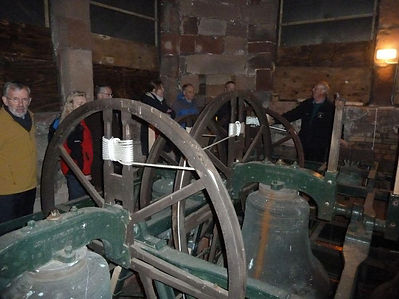
TOWER VISITING.
The tower is normally open to the public at set times during the biennial Eccleshall Festival. The next festival is in June 2018.
Visits at other times can be arranged for groups or individuals, particularly those wishing to discover more about bell ringing.
Visitors are always welcome to observe the bells being rung on Sundays between 9:30 am & 10:00 am and from 6:00pm to 6:30 pm. Also on Practice evenings on Mondays from 7:45pm to 9:15pm
If you would like to know more about The Tower, The Bells or Bell Ringing, please contact The Tower Secretary; Warren Griffiths on 01785 850948
(If you are under 18, you will need to involve a parent or guardian)
THE TOWER has 13th century, "early English", origins with a 15th century "perpendicular" extension.
Three floors provide a Ringing Room, Clock Room and Belfry
Looking at the outside, you may visualize the bells hanging between the top of the clock faces and the bottom of the window louvres.
Access to the tower is provided by an internal stone spiral staircase, climbing directly from the base of the tower inside church, to the roof. However, bell ringers normally use the external entrance, via semi circular steps on the west face.
There is access to the nave roof from the Clock Room.
We are indeed fortunate that access to the bells is very good with space above and below, which is ideal for maintenance purposes. A new walkway around the bell frame for viewing and maintenance was completed in 2014.
The Ringing Room is 31 steps above ground with another six steps to the raised ringing floor constructed in 1999. The tower is equipped with a computer system for training purposes. This allows the bells to be rung normally with the clappers silenced, but with simulated sound in the Ringing Room, thus avoiding disturbing our neighbours!
The Clock Room, 53 steps above ground, contains a clock manufactured in 1899 by Joyce of Whitchurch, Shropshire. The hour and half hours are struck on the heaviest bell hanging in the Bell Chamber. Today, the clock weights are wound electrically, but can still be hand-wound when necessary.
The Bell Chamber, 77 steps above ground. In 1553, a county wide survey of church property said the Bell Chamber "housed four great bells".(Staffordshire Historical Collections. Ref SHC 1915). Other than this reference, nothing is known of these bells.
In 1710, the Gloucester bell founder, Abraham Rudall 1 cast a new ring of six bells for Eccleshall, five of which still ring out today. For some unknown reason, the lightest of the six bells was recast in 1873 by Taylors Bell Foundry at Loughborough. Interestingly, Rudall is said to have purchased a bell from Eccleshall, dated 1659, so there may have been more than the four ancient bells noted above.
By 1948, the old wooden bell frame had become unsafe and ringing was halted.
In 1954, a new steel frame for eight bells was installed and the bells, re-hung.
In 1956, two new bells were added, the gift of the Lowe family of Sugnall.
A small "sanctus" or "call" bell also hangs in the Belfry. This bell was cast in 1735 by Abel Rudhall, grandson of Abraham 1 and is believed to have originally hung in a cote above the Bosville Chapel, now the Lady Chapel. This bell can be "chimed" from the floor of the church when a band of ringers is not available.
The ring of eight, which form a diatonic octave in the key of G#, are hung for "full circle" ringing, unique to the British Isles and some former colonial outposts.
BELL RINGING. The bells are bolted to a metal beams known as headstocks and these rotate at either end in a sealed ball race, making the bells easy to move. Attached to the headstock is a wooden wheel that guides the bell rope. When rung, the bells are spun in a complete circle and balanced in the mouth upwards position after every stroke. This allows the time interval between strokes to be controlled, so that the bells can be rung in an orderly manner. At the end of ringing, the bells can be rested against a wooden stay that prevents the bell from turning all the way over.
On starting to ring, we sound the bells in sequence, from the lightest, known as the treble, through to the heaviest, known as the tenor. We can vary this sequence either by calls being made to tell certain bells to swap place, known as "call changes" or by each ringer changing the position of their bell according to a prearranged pattern, known as " Change ringing".
Various change ringing patterns or methods can be seen in publications in the Ringing Room.
Records of events and set pieces of ringing, known as peals or quarter peals, are published in the weekly publication, "Ringing World".
TOWER ROOF. This is 104 steps above ground. The top edges of the tower battlements are 94 feet (28.65 metres) from the ground.
The massive stone pinnacles were added in recognition of Queen Victoria's Diamond Jubillee in 1897. There were originally, eight pinnacles. The four middles ones were removed for safety reasons in 1976, following a storm that blew the one of the west side through the tower roof and into the Belfry, damaging the bell frame Fortunately, the bells were not damaged. Parts of two other pinnacles fell outwards and through the pitched roofs below.
VIEWS FROM THE TOWER










